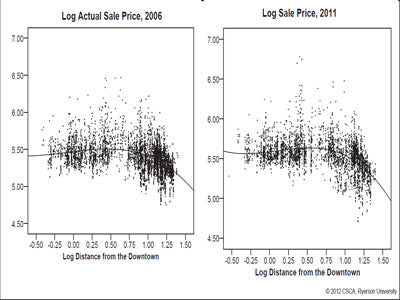
Property Valuation in the City of Toronto: A Regression Approach
By Dr. Maurice Yeates, Paul Du and Dr. Tony Hernandez
This report is a hedonic price analysis of residential sales in Toronto for 2006 (12 months) and 2011(11 months), a city of 2.6 million which is the historic core of the Greater Toronto Area (total population 6.2 million). It is concerned with estimating the implicit price of characteristics that imbue value (as measured by sale price) to individual properties in a particular year. The results indicate that for properties that have lot size measurements, a parsimonious hedonic price model for the City of Toronto is quite powerful for both 2011 and 2006 -- R2s just above 80% . The signs of the parameters are as predicted, with house features, especially lot size, and neighborhood attributes, represented by average household income, having particularly important impacts on sales price. Accessibility is also quite important with respect to the downtown, while access to the nearest subway station has the lowest impact on price, though it is increasing. The hedonic price approach becomes more complex with respect to condominiums because, with condominiums mostly in high-rises clustered around the subway system, the forces affecting sales prices operate in different ways. There appear to be two locational markets for condominiums. One, within five kilometers from the downtown, is essentially a ‘frictionless’ zone in which living area essentially determines price. In the other, beyond five kilometers from the downtown, all included variables influence price as well as the clustering effect of large site developments.
The authors would like to acknowledge and express thanks to Yvonne von Jena, Director, Product Development and Marketing, and Andrew Miller, Director of Analytics at Centract for kindly providing access to their custom data on property values in the City of Toronto; and Jan Kestle, President, Environics Analytics for access to their Demographic Estimates and Projections data. Any errors or omissions remain the responsibility of the authors.
